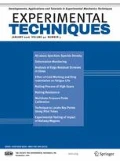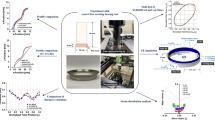Abstract
The determination of mechanical and fracture properties of anisotropic tubular materials along hoop direction needs the use of the ring hoop tensile test, for which, the obtained results are deceived by the effect of friction between the ring sample and the D-shaped block mandrel. Commonly, lubricants are applied to reduce the friction, which are inefficient in some specific cases; despite of that, it was noticed that scarce works have focused on the development of new mechanical mandrel designs or trying to improve the current ones to resolve the friction concern. The aim of this research is to correctly address the friction issue between the ring sample and the fixture mandrel to significantly reduce its effect on the ring hoop tensile test results without using any kind of lubricants. New mechanical design of D-shaped block mandrels are developed to carry out ring hoop tensile tests to simply characterize the mechanical behaviour of tubular materials. New mechanical D-shaped block mandrels were designed, manufactured and used to carry out experimental ring hoop tensile tests. An inverse identification method based on an artificial neural network trained by finite element simulation responses, was developed to efficiently segregate the flow stress curve from the influence of the friction, inherent in the global force-displacement curve for the classical ring hoop tensile test. The experimental force – displacement curves using five mandrel-types are established and quantitatively compared on the base of their ability to reduce the friction issue. The analysis of the finite element simulations, related to the investigation of the influence of the friction on the ring hoop tensile test results, shows that one of the new developed mandrels reduces the friction coefficient by about 10 times compared to that identified using the classical D-shaped block mandrel. It has been found that, the finite element simulation of ring hoop tensile test using the identified material parameters matches the experimental results. This investigation provides a useful fixture mandrel, which is able to drastically reduce the friction without resort to any lubricants to just determine the material flow stress curve using ring hoop tensile test, regardless the friction level between the sample and mandrel.
















Similar content being viewed by others
References
ASTM E8-04 (2004) Standard test methods for tension testing of metallic materials, ASTM International, West Conshohocken, PA, www.astm.org. DOI: https://doi.org/10.1520/E0008-04
Zribi T, Khalfallah A, BelhadjSalah H (2013) Experimental characterization and inverse constitutive parameters identification of tubular materials for tube hydroforming process. Mater Design 49:866–877. https://doi.org/10.1016/j.matdes.2013.02.077
Daxner T, Rammerstorfer FG, Fischer FD (2005) Instability phenomena during the conical expansion of circular cylindrical shells. Comput Methods Appl Mech Eng 194:2591–2603. https://doi.org/10.1016/j.cma.2004.07.047
Korkolis YP, Kyriakides S (2008) Inflation and burst of anisotropic aluminum tubes for hydroforming applications. Int J Plast 24:509–543. https://doi.org/10.1016/j.ijplas.2007.07.010
Korkolis YP, Kyriakides S (2011) Hydroforming of anisotropic aluminium tubes: part I experiments. Int J Mech Sci 53:75–82. https://doi.org/10.1016/j.ijmecsci.2010.11.003
Kuwabara T (2007) Advances in experiments on metal sheets and tubes in support of constitutive modeling and forming simulations. Int J Plast 23:385–419. https://doi.org/10.1016/j.ijplas.2006.06.003
Jiang H, Wang JAJ (2018) Development of cone-wedge-ring-expansion test to evaluate the tensile hoop properties of nuclear fuel cladding. Prog Nucl Energy 108:372–380. https://doi.org/10.1016/j.pnucene.2018.06.015
Magrinho JP, Silva MB, Centeno G, Moedas F, Vallellano C, Martins PAF (2019) On the determination of forming limits in thin-walled tubes. Int J Mech Sci 155:381–391. https://doi.org/10.1016/j.ijmecsci.2019.03.020
Wang H, Bouchard R, Eagleson R, Martin P, Tyson W (2002) Ring hoop tension test (RHTT): a test for transverse tensile properties of tubular materials. J Test Eval 30:382. https://doi.org/10.1520/JTE12328J
Samal MK, Balakrishnan KS, Parashar J, Tiwari GP (2014) Investigation of deformation behavior of ring-tensile specimens machined from pressure tubes of Indian PHWR. Trans Indian Inst Metals 67:167–176. https://doi.org/10.1007/s12666-013-0314-2
Price EG (1972) Hydride orientation and tensile properties of Zr-2.5wt%Nb pressure tubing hydrided while internally pressurized. Can Metall Q 11:129–138. https://doi.org/10.1179/cmq.1972.11.1.129
Arsene S, Bai J (1996) A new approach to measuring transverse properties of structural tubing by a ring test. J Test Eval 24:386. https://doi.org/10.1520/JTE11461J
Arsène S, Bai J (1998) A new approach to measuring transverse properties of structural tubing by a ring test -experimental investigation ASTM. J Test Eval 26:26–30. https://doi.org/10.1520/JTE11966J
Arsène S, Bai J, Bompard P (2003) Hydride embrittlement and irradiation effects on the hoop mechanical properties of pressurized water reactor (PWR) and boiling-water reactor (BWR) ZIRCALOY cladding tubes: part III. Mechanical behavior of hydride in stress-relieved annealed and recrystall Metall Mater Trans A 34:579–588. https://doi.org/10.1007/s11661-003-0093-1
Yoon SH, Cho WM, Kim CG (1997) Measurement of modulus in filament wound ring specimen using split disk test. Exp Tech 21:25–28. https://doi.org/10.1111/j.1747-1567.1997.tb00488.x
Seok CS, Bae BK, Koo JM, Murty KL (2006) The properties of the ring and burst creep of Zirolo cladding. Eng Fail Anal 13:389–397. https://doi.org/10.1016/j.engfailanal.2005.02.009
Walsh EJ, Adams DO (2008) Development and evaluation of the quadrant ring test method. Proc Soc Exp Mech Inc 65:319–326. https://doi.org/10.1007/s11340-007-9089-x
He Z, Yuan S, Zha W, Liang Y (2008) Force and deformation analysis of tube ring specimen during hoop tension test. Jinshu Xuebao/Acta Metall Sin 44:423–427
He Z, Yuan S, Liu G, Wu J, Cha W (2010) Formability testing of AZ31B magnesium alloy tube at elevated temperature. J Mater Process Technol 210:877–884. https://doi.org/10.1016/j.jmatprotec.2010.01.020
Kim SK, Bang JG, Kim DH, Lim IS, Yang YS, Song KW, Kim DS (2009) Hoop strength and ductility evaluation of irradiated fuel cladding. Nuc Eng and Design 239:254–260. https://doi.org/10.1016/j.nucengdes.2008.10.024
Desquines J, Koss DA, Motta AT, Cazalis B, Petit M (2011) The issue of stress state during mechanical tests to assess cladding performance during a reactivity-initiated accident (RIA). J Nucl Mater 412:250–267. https://doi.org/10.1016/j.jnucmat.2011.03.015
Nagase F, Sugiyama T, Fuketa T (2009) Optimized ring tensile test method and hydrogen effect on mechanical properties of zircaloy cladding in hoop direction. J Nucl Sci Technol 46:545–552. https://doi.org/10.1080/18811248.2007.9711560
Martín-Rengel MA, Gómez Sánchez FJ, Ruiz-Hervías J, Caballero L, Valiente A (2012) Revisiting the method to obtain the mechanical properties of hydrided fuel cladding in the hoop direction. J Nucl Mater 429:276–283. https://doi.org/10.1016/j.jnucmat.2012.06.003
Samal MK, Balakrishnan KS, Parashar J, Tiwari GP, Anantharaman S (2013) Estimation of transverse tensile behavior of Zircaloy pressure tubes using ring-tensile test and finite element analysis. Proc Inst Mech Eng Part C J Mech Eng Sci 227:1177–1186. https://doi.org/10.1177/0954406212460474
Dick CP, Korkolis YP (2014) Mechanics and full-field deformation study of the ring hoop tension test. Int J Solids Struct 51:3042–3057. https://doi.org/10.1016/j.ijsolstr.2014.04.023
Al-Khaled MA, Barsoum I (2018) New ring specimen geometries for determining the failure locus of Tubulars. J Press Vessel Technol Trans ASME 140. https://doi.org/10.1115/1.4038311
Barsoum I, Al Ali KF (2015) A procedure to determine the tangential true stress-strain behavior of pipes. Int J Press Vessel Pip 128:59–68. https://doi.org/10.1016/j.ijpvp.2014.11.002
Panicker SS, Prasad KS, Sawale G, Hazra S, Shollock B, Panda SK (2019) A warm redrawing of AA6082 sheets and investigations into the effect of aging heat treatment on cup wall strength. Mater Sci Eng A 768:138445. https://doi.org/10.1016/j.msea.2019.138445
Ktari Z, Leitão C, Prates PP, Khalfallah A (2021) Mechanical design of ring tensile specimen via surrogate modelling for inverse material parameter identification. Mech Mater 153:103673. https://doi.org/10.1016/j.mechmat.2020.103673
Mehan RL, Jackson MR, Rairden JR, Carter WT (1987) The use of a ring tensile test to evaluate plasma-deposited metals. J Mater Sci 22:4476–4483. https://doi.org/10.1007/BF01132050
Cui XL, Yuan SJ (2016) Determination of mechanical properties of anisotropic thin-walled tubes under three-dimensional stress state. Int J Adv Manuf Technol 87:1917–1927. https://doi.org/10.1007/s00170-016-8526-3
Yuan S, He Z, Liu G (2012) New developments of hydroforming in China. Mater Trans 53:787–795. https://doi.org/10.2320/matertrans.MF201122
Zhou JB, Sun PY, Zhou CY, He XH (2019) Experimental characterization of anisotropic tensile mechanical behavior of pure titanium tube. J Iron Steel Res Int 26:91–101. https://doi.org/10.1007/s42243-018-0210-4
Leitão C, Loureiro A, Rodrigues D. (2012) Assessment of mechanical shear response using digital image correlation, in: J.F. Silva Gomes and Mário a.P. Vaz (Ed.), 15th international conference on experimental mechanics. Porto, Portugal, pp. 1–10
Yan Y, Wang H, Li Q (2015) The inverse parameter identification of hill 48 yield criterion and its verification in press bending and roll forming process simulations. J Manuf Process 20:46–53. https://doi.org/10.1016/j.jmapro.2015.09.009
Zhou RS, Hoeprich MR (1991) Torque of tapered roller bearings. ASME J Tribol 113(3):590–597. https://doi.org/10.1115/1.2920664
Pini V (2008) E, (2008) friction in cylindrical roller bearings russian engineering research, Allerton press, Inc 28. No. 1:1–4. https://doi.org/10.3103/S1068798X08010012
Aguir H, BelHadjSalah H, Hambli R (2011) Parameter identification of an elasto-plastic behaviour using artificial neural networks-genetic algorithm method. Mater Design 32:48–53. https://doi.org/10.1016/j.matdes.2010.06.039
Pontes FJ, Paiva AP, Balestrassi PP, Ferreira JR, Da Silva MB (2012) Optimization of radial basis function neural network employed for prediction of surface roughness in hard turning process using Taguchi’s orthogonal arrays. Expert Syst Appl 39:7776–7787. https://doi.org/10.1016/j.eswa.2012.01.058
Bozdemir M (2018) Prediction of surface roughness considering cutting parameters and humidity condition in end milling of polyamide materials. Comput Intell Neurosci 1–7. https://doi.org/10.1155/2018/5850432
Kialashaki A, Reisel JR (2014) Development and validation of artificial neural network models of the energy demand in the industrial sector of the United States. Energy 76:749–760. https://doi.org/10.1016/j.energy.2014.08.072
Mahalle G, Salunke O, Kotkunde N, Gupta AK, Singh SK (2019) Neural network modeling for anisotropic mechanical properties and work hardening behavior of Inconel 718 alloy at elevated temperatures. J Mater Res Technol 8:2130–2140. https://doi.org/10.1016/j.jmrt.2019.01.019
Ciurana G.Q. M.L.G.J. (2011) Surface roughness monitoring application based on artificial neural networks for ball-end milling operations 607–617. https://doi.org/10.1007/s10845-009-0323-5
Burden F, Winkler D. (2008) Bayesian regularization of neural networks. Artificial Neural Networks: Methods and Applications; Humana press: Totowa, NJ, USA
Acknowledgements
This research is sponsored by FEDER funds through the program COMPETE – Programa Operacional Factores de Competitividade – and by national funds through FCT – Fundação para a Ciência e a Tecnologia, under the project UID/EMS/00285/2020. It was also supported by the project RDFORMING (reference PTDC/EME-EME/31243/2017), co-funded by Portuguese Foundation for Science and Technology, by FEDER, through the program Portugal-2020 (PT2020), and by POCI, with reference POCI-01-0145-FEDER-031243. Both supports are gratefully acknowledged.
Author information
Authors and Affiliations
Corresponding author
Ethics declarations
Declaration of Interests
The authors declare that they have no known competing financial interests or personal relationships that could have appeared to influence the work reported in this paper.
Additional information
Publisher’s Note
Springer Nature remains neutral with regard to jurisdictional claims in published maps and institutional affiliations.
Rights and permissions
About this article
Cite this article
Khalfallah, A., Ktari, Z., Leitão, C. et al. New Mandrel Design for Ring Hoop Tensile Testing. Exp Tech 45, 769–787 (2021). https://doi.org/10.1007/s40799-021-00462-4
Received:
Accepted:
Published:
Issue Date:
DOI: https://doi.org/10.1007/s40799-021-00462-4




